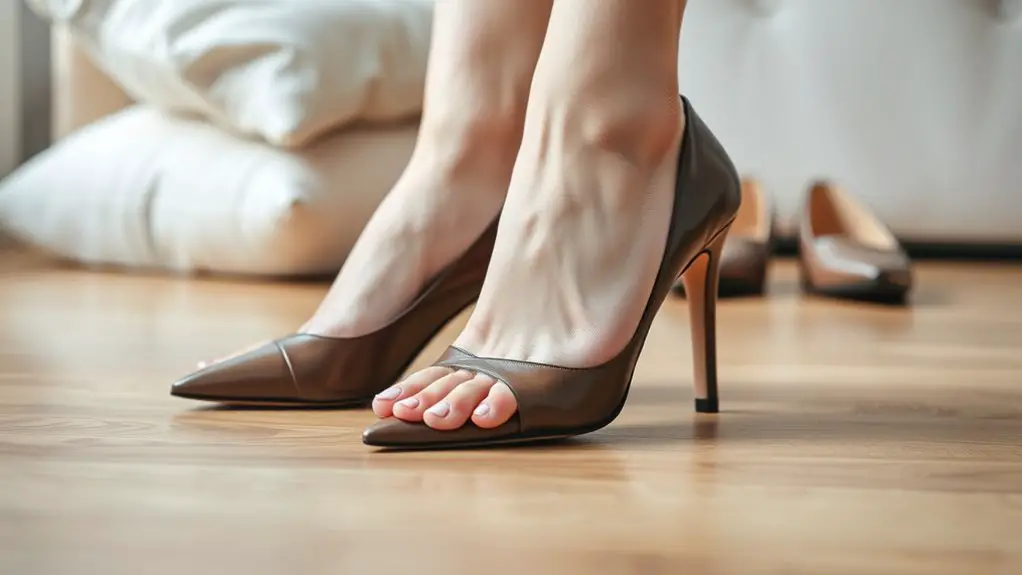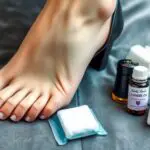High heels can cause toe pain because they compress your toes and shift your foot’s natural alignment, increasing pressure on sensitive areas. Conditions like bunions and metatarsalgia often arise due to this excessive strain. To prevent pain, choose heels with a lower height and a wider toe box to allow for natural toe movement. Orthotic insoles and alternating footwear can also help. For more tips on maintaining foot health while wearing heels, keep exploring the information available.
Understanding the Anatomy of the Foot and High Heels
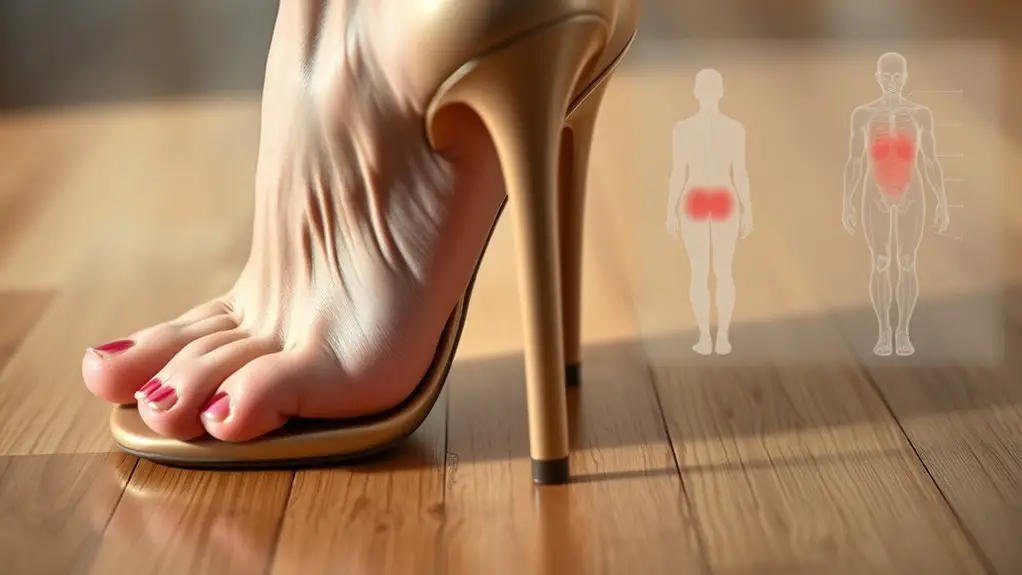
The human foot is a complex structure, consisting of 26 bones, multiple joints, and a network of ligaments and tendons that work together to provide both mobility and support. Understanding this intricate anatomy is vital, especially when considering the impact of heel height on foot structure. High heels elevate the heel while compressing the toes, altering the foot’s natural alignment. This shift can lead to an increased load on the forefoot, which affects the distribution of weight and can compromise stability.
As you wear heels, the elevated position forces the foot into an unnatural posture, leading to potential strain on the metatarsals and surrounding tissues. Over time, this can result in discomfort and pain. Awareness of how heel height influences foot anatomy is essential for making informed choices about footwear, helping you maintain foot health while enjoying stylish options. Understanding your foot’s structure can lead to better footwear choices that minimize discomfort.
Common Foot Problems Associated With High Heels
Wearing high heels can lead to a variety of foot problems due to the unnatural positioning they impose. One common issue is bunions development, where the big toe deviates towards the other toes, creating a painful bump on the foot. This condition often arises from the constricted toe box of high heels, forcing your foot into an unnatural shape.
Another prevalent problem is metatarsalgia symptoms, characterized by pain and inflammation in the ball of the foot. The elevated heel height shifts weight forward, increasing pressure on the metatarsal bones. This can lead to discomfort and difficulty walking, particularly if high heels are worn frequently.
Both conditions not only cause immediate pain but may also lead to chronic issues if not addressed. It’s essential to be aware of these potential problems and take preventive measures to maintain foot health while enjoying your favorite heels.
Factors That Contribute to Toe Pain in Heels
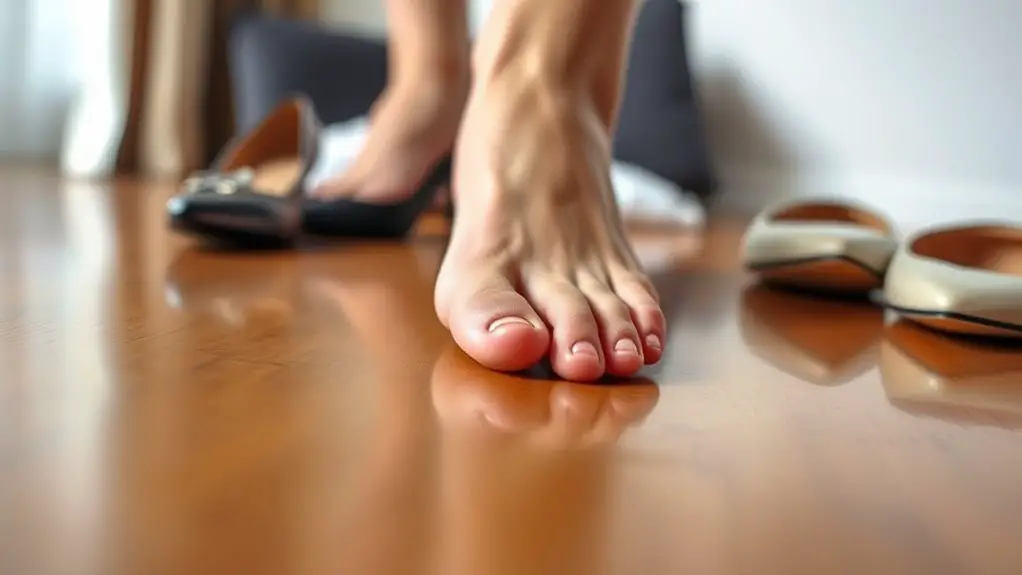
While indulging in fashionable high heels may seem appealing, various factors can considerably contribute to toe pain. The foot structure plays an essential role in how your toes respond to the confined space of high-heeled shoes. When you wear heels, your foot is forced into an unnatural position, which can compress the toes and lead to discomfort.
Additionally, high heels often place excessive pressure on specific pressure points in the forefoot, exacerbating pain. The elevated heel shifts your weight forward, increasing the load on the metatarsal bones and the toe joints. Over time, this can lead to conditions like bunions, hammertoes, or neuromas, which are all associated with high-heeled footwear.
Understanding these factors can help you recognize how your choice of footwear affects your foot health and toe comfort. By being mindful, you can take steps to mitigate these issues before they escalate.
Tips for Choosing the Right High Heels
Choosing the right high heels can significantly reduce the risk of toe pain, especially if you consider factors such as fit, heel height, and toe box design. Start by selecting a heel height that aligns with your comfort level. A lower heel height can minimize pressure on your toes, while excessively high heels can exacerbate pain.
Next, pay attention to the toe box. Opt for shoes with a wider toe box that allows your toes to spread naturally, reducing cramping and friction. Avoid pointed-toe designs, as they can lead to misalignment and increased pressure on your toes.
Additionally, make sure the shoes fit snugly but not too tightly. A proper fit prevents excess movement that can cause blisters and irritation. Finally, consider materials that provide flexibility and breathability, as these can enhance comfort during wear. By focusing on these factors, you can help safeguard against toe pain while enjoying high heels.
Effective Strategies for Alleviating Toe Pain
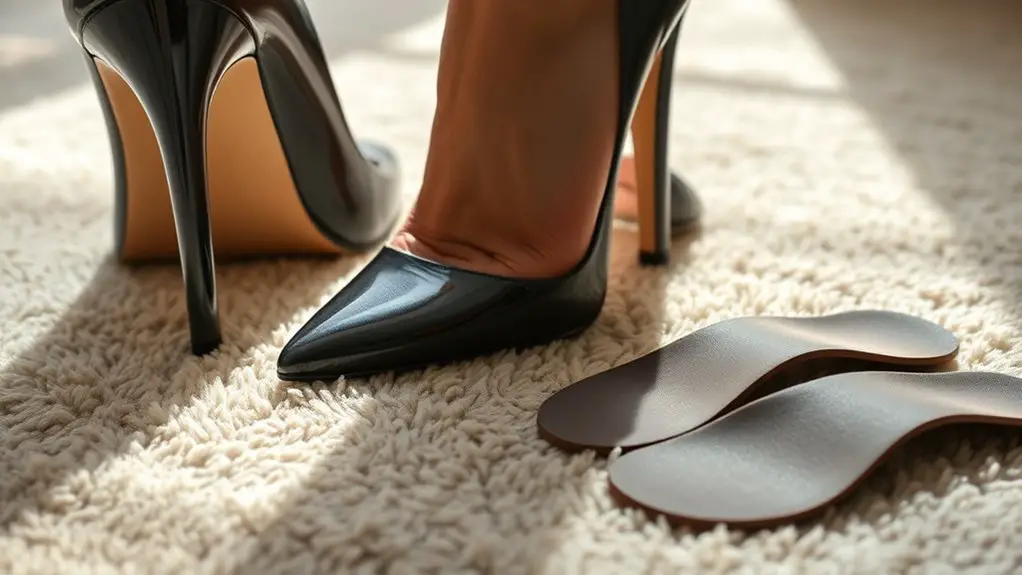
If you find yourself experiencing toe pain after a night in heels, implementing effective strategies can help alleviate discomfort and promote recovery. Start with targeted pain relief methods, such as ice therapy. Applying ice to your toes for 15-20 minutes can reduce inflammation and numb the area.
Experiencing toe pain after a night in heels? Try ice therapy for relief and inflammation reduction.
Incorporate specific foot exercises into your routine to strengthen the muscles and improve flexibility. Toe stretches, towel curls, and marble pickups are excellent exercises that can alleviate tension.
Additionally, consider using orthotic insoles designed for high heels; these can provide extra cushioning and support, distributing pressure more evenly across your feet.
Finally, allow ample recovery time by alternating between heels and more supportive footwear. By following these strategies, you’ll not only find relief from toe pain but also enhance the overall health of your feet, making high heel wear more enjoyable in the long run.
Frequently Asked Questions
Can Wearing Heels Affect My Overall Posture?
Yes, wearing heels can negatively impact your posture alignment. Elevated heels shift your center of gravity, increasing muscle tension in your back and legs, leading to discomfort and potential long-term postural issues if worn frequently.
Are There Specific Heel Heights That Are Safer for My Feet?
Ever wonder which heel heights are safer for your feet? Low rise heels or wedge options generally provide better stability and distribute weight more evenly, reducing potential strain compared to higher heels. Choose wisely for comfort!
How Often Should I Take Breaks While Wearing Heels?
You should take breaks every hour while wearing heels to minimize discomfort. Consider varying your break frequency based on your activity level and explore heel alternatives for longer wear to improve foot health and comfort.
Can Toe Pain From Heels Lead to Long-Term Foot Issues?
Yes, toe pain from wearing heels can lead to chronic pain and joint issues over time. It’s essential to address discomfort early to prevent long-term complications and maintain overall foot health and mobility.
Do Different Heel Materials Impact Toe Pain Levels?
Yes, different heel materials impact toe pain levels. Leather heels often provide better cushioning effects than plastic heels. Additionally, heel stiffness varies, influencing comfort and pressure on your toes, potentially leading to pain or discomfort.

